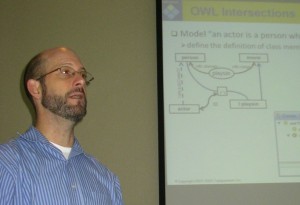Learn more
- Oct 14, 2009
Attending TopQuadrant’s SemWeb Technology Training
There’s a lot to know about semantic standards, languages, technologies and their application, so last week I attended TopQuadrant’s first European training from Oct 5th to 9th in Amsterdam.
We kicked off with Eddy Vanderlinden elaborating on the lessons he learned from 30 years of work in the financial sector. He outlined how improvements could be achieved by using data models relying on semantic web standards. You can read about his ideas in this essay.
TQ’s chief scientist Dean Allemang then continued with his talk “Enabling Creativity at the Edge”. “The edge” refers to the boundary between an information system and the real world, where the end users of a system work. As business needs change faster and faster, the people working at the edge need to be able to adapt the company’s applications on their own and shape them to their everyday needs.

Nowadays end user often achieve this kind of creativity on the edge by using self-made spreadsheets. The problem with that is their lack of interoperability. These data from different spreadsheets, databases, reports, etc. are often connected through business processes that rely on repetitive and error prone human processing, like copying things from a spreadsheet to a database, creating a report and pasting its result into another system, and so on.
The result is a complex system with many heterogenous parts and an organisation that cannot possibly know what it knows.
As a solution Dean proposed to “think outside the table” and go beyond the relational database way of orgranising data. This of course can be achieved by integrating the data using semantic technologies. TopQuadrant’s software offers possibilities to do just that, and makes it possible to create highly customizable dashboards and applications that all rely on the same data.
During the following days we learned about the ins and out of using semantic standards and languages and tried out TopBraid tools in several hands-on excercises. The TopBraid Suite is a very powerful, commercial toolkit. It includes TopBraid Composer, Live and Ensemble. Composer is a semantic web modeling and application developement tool, that uses the Eclipse framework. TopBraid Live is a server for semantic applications built with TopBraid Ensemble. Ensemble is a graphical application assembly toolkit, that enables end users to create custom apps that run in a browser and use RDF data and data models – thereby allowing for the above mentioned “creativity at the edge”.
I am very impressed with the capabilities of these tools, they enable the user to realize manifold possibilities that come with using semantic web standards – and that without programming. You can see some of these tools in action and learn about applying semantic standards in a series of webcasts from Semantic Universe. For the latter topic you might also attend one of our webinars.
On the last day Dean coverd several case studies, like connecting ontologies to legacy data sources (using e.g. D2RQ inside Composer), applying semantic technologies to the customer service management of a larger retailer or using ontologies in Federal Enterprise Architecture.
All in all I am very happy to have attended TopQuadrant’s training and hope they will establish a successful series of trainings in Europe just as they did in the US.